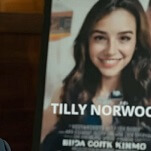Westerns are now so rare that the occasional few that get made tend to be fairly extravagant, high-concept affairs—Brad Pitt as Jesse James, a Coen Brothers remake of True Grit, etc. Back in their heyday, however, they were so plentiful that the genre consisted mostly of “programmers”: inexpensive pictures featuring lesser-known actors and simple, streamlined narratives, meant to occupy the bottom half of a double-bill. Jared Moshé’s debut feature, Dead Man’s Burden, is a throwback to the programmers of yore, shot mostly on a single location and embroiling four stock characters in a very basic scenario. It plays like the kind of movie you’d stumble onto watching TCM late at night and get sucked into against your will, amazed that something you’d never heard of, with no purchase in film history, could be this absorbing.
Like a lot of those old movies, Dead Man’s Burden opens with an attention-grabbing murder. Homesteader Clare Bowen shoots down an older man who’s quickly revealed to be her father, though her motivation for the killing is kept murky for a bit longer. It’s abundantly clear, however, that the last thing she wants is for her brother (Barlow Jacobs) to find out about it. Yet Jacobs isn’t exactly a paragon of virtue himself, having just returned home as (1) a deserter from (2) the Union Army. (Time and place are never specified, but the film seems to be set on the Southern border sometime around 1870.) Complicating matters are Bowen’s fella (David Call), a distrustful sort with carefully hidden psychopathic tendencies, and the arrival of a citified dandy (Joseph Lyle Taylor) who wants to purchase the family farm, though not necessarily for a fair price.
Dead Man’s Burden runs a trim 93 minutes—still probably 10-15 minutes longer than it would have back in the day—and wastes very little energy, confidently escalating the tension notch by notch. All four actors turn in sturdy, unfussy performances that do old Hollywood’s bit players proud. And the movie even looks like a proper Western, despite its low budget, thanks to Moshé’s stubborn decision to shoot it on 35mm. (In an especially creative move, he relies largely on photochemical sensitivity to bright light for his two big action sequences, thereby making up for an over-reliance on modern-day shaky-cam.) The story is modest to the point of occasionally seeming slight, and the ending is a tad too cute in the way it circles back to the beginning, but even those flaws just make it feel more authentic. See it now, before it gets rediscovered.








































